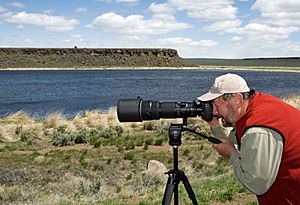Nature photography facts for kids
Nature photography is a type of photography that captures the beauty of the natural world. This can include stunning landscapes, amazing wildlife, and beautiful plants. It also covers close-up shots of natural details and textures, like a dewdrop on a leaf or the bark of a tree.
Unlike photojournalism or documentary photography, which focus on telling a story or recording facts, nature photography often aims to create a picture that is very pleasing to look at. These wonderful photos are often seen in science, travel, and cultural magazines, helping people appreciate the world around them.
Contents
What is Nature Photography?
Nature photography is all about taking pictures of things found in nature. This can be anything from huge mountains and vast oceans to tiny insects and delicate flowers. The goal is to show the beauty and wonder of our planet.
Types of Nature Photography
There are many different kinds of nature photography, each with its own focus:
- Landscape photography: This involves taking pictures of wide outdoor scenes, like mountains, forests, deserts, or coastlines. Photographers often try to capture the mood of a place, like a misty morning or a fiery sunset.
- Wildlife photography: This focuses on animals in their natural homes. It takes a lot of patience and skill to photograph wild animals without disturbing them.
- Plant photography: This type of photography captures the beauty of plants, from tiny mosses to giant trees. It can include close-ups of flowers, leaves, or even seeds.
- Macro photography: This is a special kind of close-up photography. It makes small subjects, like insects or tiny details of plants, appear very large in the picture.
- Weather photography: Some photographers specialize in capturing weather events, such as storms, lightning, or rainbows.
How to Take Great Nature Photos
Taking good nature photos requires more than just pointing a camera. Here are some tips:
Understanding Light
Light is super important in photography. The best times to take nature photos are often during the "golden hour," which is shortly after sunrise or before sunset. The light is soft and warm then, making everything look beautiful. Overcast days can also be great for soft, even light, especially for plants and close-ups.
Using the Right Gear
You don't need the most expensive camera, but certain tools can help:
- Cameras: Digital SLR (DSLR) or mirrorless cameras offer lots of control. Even a good smartphone camera can take amazing nature photos these days.
- Lenses: Different lenses are used for different subjects. A wide-angle lens is good for landscapes, while a telephoto lens helps you get close to wildlife from a distance. A macro lens is perfect for tiny subjects.
- Tripods: A tripod keeps your camera steady, which is very important for sharp photos, especially in low light or when using long exposure times.
Being Patient and Respectful
Nature photography often means waiting for the perfect moment. For wildlife, this might mean waiting hours for an animal to appear or do something interesting. It's also crucial to be respectful of nature. Always stay on marked paths, don't disturb animals or plants, and leave no trace behind. The goal is to capture nature's beauty without harming it.
History of Nature Photography
Early photography, starting in the 1800s, quickly turned to nature. People were amazed by how cameras could capture landscapes and natural scenes in detail.
Pioneers of Nature Photography
- Early landscape photographers: In the mid-1800s, photographers like Carleton Watkins and William Henry Jackson took amazing pictures of the American West. Their photos helped convince people to protect these wild places, leading to the creation of national parks.
- Ansel Adams: One of the most famous nature photographers was Ansel Adams (1902–1984). He was known for his stunning black-and-white landscape photos of the American West, especially Yosemite National Park. He used special techniques to make his prints look incredibly detailed and dramatic. His work helped show the power and beauty of nature.
Today, nature photography continues to be a popular and important art form. It helps us connect with the natural world and reminds us why it's so important to protect our planet.
Images for kids
-
Natural sources are popular places for nature photography. Lahemaa National Park in Estonia.
-
Indian elephants at Mudumalai National Park, India
-
Nature photography includes images from both large and small subjects. Photo of a beetle using focal length of 60 mm and a shutter speed of 1/320 second.
-
Black-and-white landscape photograph by Ansel Adams
See also
 In Spanish: Fotografía de naturaleza para niños
In Spanish: Fotografía de naturaleza para niños








